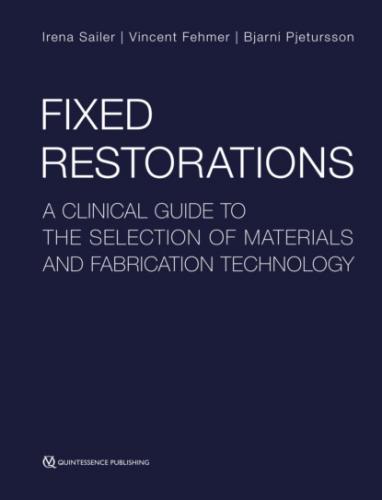Fixed Restorations. Irena Sailer
The fillers are mainly silica or quartz, as well as barium- or strontium-containing silica glasses providing radiopacity, and sometimes ytterbium fluoride, which shows a slight release of fluoride. The particles are incorporated in order to reinforce the material and to scatter the light, thus supporting a tooth-like appearance of the restoration.
For Lava Ultimate (3M ESPE, Seefeld, Germany) the indication “single crown” is excluded due to frequent problems with debonding. In a clinical trial with this material on zirconia abutments an extreme rate of debonding of 80% in the first year was observed14. It is unclear whether the high debonding rate is transferable to other composite materials. In any case the bonding procedure has to be carefully observed and manufacturer recommendations should be followed15. Particle-filled polymers need to be adhesively cemented to the tooth substrate. To increase the surface area and thereby the bond strength, the bonding area must be airborne-particle abraded according to the manufacturer’s recommendations. Chemical bonding is obtained by a primer containing methacrylates and silane, where the methacrylates bond to the polymer matrix and the silane to the ceramic fillers (Fig 1-1-14).
Fig 1-1-14 Chemical structure of silanes and their intermediate bonding to polymer and ceramic surfaces.
Polymer-infiltrated ceramic
The main component of this type of composite is a sintered porous ceramic network, which is infiltrated by polymer (Fig 1-1-15). There is only one product available (Vita Enamic, Vita Zahnfabrik, Bad Säckingen, Germany). The composition is 86% by mass of a fine-grained ceramic and 14% by mass of a mixture from UDMA and TEGDMA. The manufacturer recommends the material for all single tooth restorations as well as implant-supported crowns. The strengthening mechanism in this material is again the use of phase boundaries between polymer and ceramic to stop or deviate cracks. Furthermore, cracks are dissipated and thereby lose energy (Fig 1-1-16).
Fig 1-1-15 Microstructure of a polymer-infiltrated ceramic.
Figs 1-1-16a and 1-1-16b Crack development originating from an indentation. (a) In polymer-infiltrated ceramic the crack is dissipated due to multiple phase boundaries. (b) In feldspar ceramic the crack runs straight through the material.
Polymer-infiltrated ceramic restorations need to be adhesively cemented to the underlying tooth substrate or abutment. The material provides excellent bond strength similar to ceramics due to a micro-retentive etch pattern when etched with hydrofluoric acid (Fig 1-1-17); however, silane should be applied to the intaglio surface of the restoration to improve bond strength16–18.
Fig 1-1-17 Etch pattern of polymer-infiltrated ceramic (60 sec with 5% hydrofluoric acid).
Silicate ceramics
The ceramic materials routinely used in restorative dentistry today encompass feldspar ceramics and lithiumsilicate glass-ceramics.
Small crystalline particles are used to reinforce the material, analogue to the particle reinforcement in composites. When the particles are created by crystallization of a glass in a well-defined temperature profile, the term glass-ceramic is used for these materials. These particles support the optical properties of silicate ceramics. The light may pass through the glassy phase and refraction will occur at the phase boundaries between glass phase and crystalline phase (cf. Fig 1-1-9). The more crystals are present the more phase boundaries are effective and the material gets more and more white and opaque, because the light is more and more reflected.
Feldspar ceramics
Feldspars are a group of minerals composed of alkaline oxides, alkaline earth oxides, alumina, and silicate. Feldspar-based ceramics have the most tooth-resembling optical properties compared to other dental materials and lead to high esthetic outcomes.
As the mechanical stability of these ceramics is rather low, their indication is limited to single tooth restorations. For sufficient stability during clinical function, feldspathic ceramic restorations have to be adhesively cemented to enamel and, thereby, are reinforced. Hydrofluoric acid etching provides a microretentive etch pattern, which after silanization offers sufficient bond strength16. The main application for the feldspathic CAD/CAM blanks is the chairside fabrication of single-unit restorations like veneers, inlays, onlays, and partial crowns.
The results of a systematic review showed that early feldspathic single crowns exhibit significantly lower survival rates than other all-ceramic crown types, especially when manually layered19. However, in the beginning of the 1990s, a feldspathic CAD/CAM material (VITABLOCS Mark II, Vita Zahnfabrik) was developed in line with the CEREC system (Dentsply Sirona, York, PA, USA), which is still on the market, successful, and unchanged over three decades.
Some of the current feldspathic materials are reinforced by leucite, a feldspathoid (IPS Empress, Ivoclar Vivadent, Schaan Liechtenstein; Paradigm C, 3M ESPE, Seefeld, Germany)20,21, others (VITABLOCS Mark II, VITABLOCS Triluxe forte, VITABLOCS RealLife, Vita Zahnfabrik) by sanidine and anorthoclase, minerals of the feldspar group as well as nepheline, a feldspathoid22. These particles develop during the production process. Feldspar ceramic is also available for press technology.
Lithium-silicate glass-ceramics
It is well known from household items that glass-ceramic is a very strong and durable material. The idea was to adapt the material for dental application21. The glass-ceramic is based on a lithium-silicate glass, which is rather weak and therefore machinable. Via thermal treatment the glass partially crystallizes. The crystals act as particle reinforcement and increase strength while mimicking the optical properties of tooth substance (reflection, scattering of light)21.
Two types of glass-ceramics were developed over the years. In the first material (IPS e.max, Ivoclar Vivadent, Schaan, Liechtenstein) lithium-disilicate (Li2[Si2O5]) is the main crystalline phase. In a further development, the main crystalline phase was changed to lithium-metasilicate (Li2[SiO3]) and zirconia was added in an amount of 10 weight%, solved in the glass phase23 for the purpose of strengthening it (Celtra Duo, Dentsply Sirona; Vita Suprinity PC, Vita Zahnfabrik). The crystals are much smaller compared to lithium-disilicate (Fig 1-1-18), resulting in better wear properties when opposing human enamel24.
Figs 1-1-18a and 1-1-18b Microstructure of glass-ceramics. (a) Lithium-disilicate (IPS e.max CAD). (b) Lithium-metasilicate (Suprinity PC).
